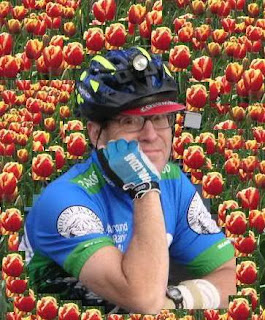This is a mish-mash of tips, some commonly heard and some less-so, that I have come to over three decades of riding bikes.The intention is to include a mix of tips that might appeal to a wide variety of folks with a broad set of interests, skills and commute routes.Have fun and get out there on your bike.
Be attentive and be safe
–Situational awareness is of central importance when travelling by bicycle
–Look out for turning traffic (in front of you, oncoming traffic and from side streets)
–Don’t ride in the door zone
–Be visible, with good lane positioning and brightly colored gear
–Take the lane when you need to for safety reasons
Keep it fresh, mix it up
–Vary your route.Especially on your ride home extend your ride along a fun or scenic route.
–Ride different bikes.If you have more than one bike, don’t always commute on the same one.
–Wear different clothes, shoes and helmets on different days and in different seasons.
Have a snack
–If you like trail riding, find all the little bits of singletrack anywhere near your commute.In fact, just this morning I snacked on a little stretch of trail as I detoured around a construction zone.
–Stop and smell the flowers along the way.Take a deep breath at a scenic vista.Practice tai chi at the local park.Or meet your friends for coffee en-route to work.
Be imaginative
–Create your own mythologies for inspiration…just remember to NOT really believe in them
–A healthy fantasy life can help your psych to ride.For example, when you mount your bike you might become a bicycle/human cyborg or a two-wheeled centaur whose mission is to ______________.Just don’t explain that one to your boss, the police or your significant other.
Be well-equipped
–Have the right gear for the job.Carry a pump, tube, patch kit and mini tool and know how to use them
–If you are riding in Minneapolis in the winter, studded tires might be in order
–If you are commuting through a Pacific Northwest winter, you really ought to have fenders
–In Honolulu or Houston hydration and sun protection are key
Get better
–Learn more about bicycle mechanics so that you are more self-reliant on the road
–Improve your handling skills.For example; learn how to bunnyhop so you can more safely and easily avoid road hazards.
–Learn traffic law for bicycles and follow the rules.Become a better bicycling ambassador
–Take a safe cycling skills course
Get hooked
–Keep riding when the fall and winter weather rolls in. If you ride through fall and winter it is much easier to ride in the early spring too.We readily adapt to the gradual changes in weather as we ride daily throughout the year.Inertia plays an important role in our habits.
–Get multi-modal on it.Use transit and bikes together where possible to extend your “cruising range.”
Want a brochure with bike commuting tips? Sign up for our e-news and request it on the form
Please select a valid form
 everybodyBIKE organized a series of 17 Summer Rides that take place every other Friday and Sunday. These rides have been phenomenally successful, ranging in participation from 10 -100 people! Participants also vary in age from little kids in trailers to 80 years old. There are cruisers, mountain bikes, road bikes, people in spandex and bike shoes, as well as dress clothes and heels. It’s a wonderful mix of people who are joined together for a common love, bikes.
everybodyBIKE organized a series of 17 Summer Rides that take place every other Friday and Sunday. These rides have been phenomenally successful, ranging in participation from 10 -100 people! Participants also vary in age from little kids in trailers to 80 years old. There are cruisers, mountain bikes, road bikes, people in spandex and bike shoes, as well as dress clothes and heels. It’s a wonderful mix of people who are joined together for a common love, bikes.

